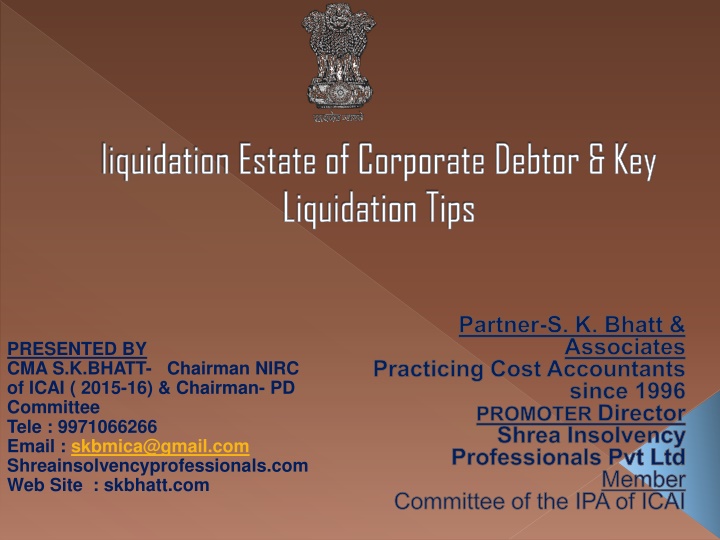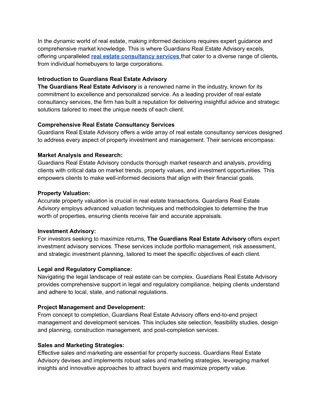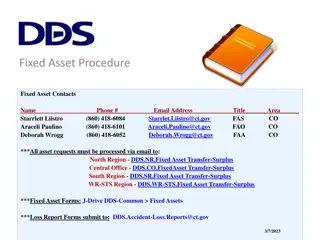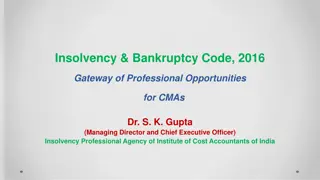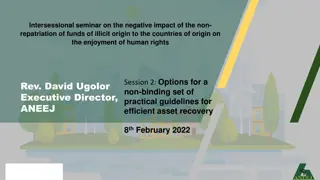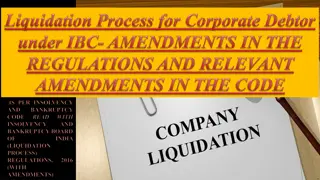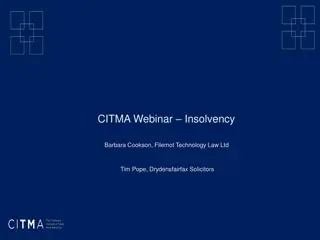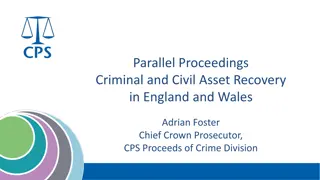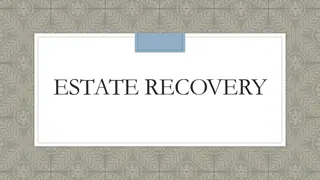Liquidation Estate and Key Asset Components
In the process of liquidation, the liquidator forms an estate comprising various assets of the corporate debtor for the benefit of creditors. These assets include ownership rights, tangible and intangible assets, proceeds of liquidation, and more. However, certain assets owned by third parties or held in trust are excluded from the liquidation estate.
Download Presentation

Please find below an Image/Link to download the presentation.
The content on the website is provided AS IS for your information and personal use only. It may not be sold, licensed, or shared on other websites without obtaining consent from the author.If you encounter any issues during the download, it is possible that the publisher has removed the file from their server.
You are allowed to download the files provided on this website for personal or commercial use, subject to the condition that they are used lawfully. All files are the property of their respective owners.
The content on the website is provided AS IS for your information and personal use only. It may not be sold, licensed, or shared on other websites without obtaining consent from the author.
E N D
Presentation Transcript
liquidation Estate of Corporate Debtor & Key Liquidation Tips Partner-S. K. Bhatt & Associates Practicing Cost Accountants PRESENTED BY CMA S.K.BHATT- Chairman NIRC of ICAI ( 2015-16) & Chairman- PD Committee Tele : 9971066266 Email : skbmica@gmail.com Shreainsolvencyprofessionals.com Web Site : skbhatt.com since 1996 PROMOTER Director Shrea Insolvency Professionals Pvt Ltd Member Committee of the IPA of ICAI
Liquidation Estate( Section 36) The liquidator shall form an estate of the assets which will be called the liquidation estate for Corporate Debtors The liquidator shall hold the liquidation estate as a fiduciary for the benefit of all the creditors. Liquidation estate shall comprise all liquidation estate assets which shall include the following: - 1) any assets over which the corporate debtor has ownership rights, including all rights and interests therein as evidenced in the balance sheet of the corporate debtor
2)Assets that may or may not be in possession of the corporate debtor including but not limited to encumbered assets 3)Tangible assets, whether immovable 4)Intangible assets including but not limited to intellectual property, securities and financial instruments, insurance policies, contractual rights 5)Assets subject to the determination of ownership by the court or authority 6)Any assets or their value recovered through proceedings for avoidance of transactions movable or
7) Any asset of the corporate debtor in respect of which a secured creditor has relinquished security interest. 8) Any other property belonging to or vested in the corporate debtor at the insolvency commencement date; and 9) All proceeds of liquidation as and when they are realised
The following shall not be included in the Liquidation Estate Assets (a)Assets owned by a third party which are in possession of the corporate debtor, including (i) Assets held in trust for any third party; (ii) Bailment contracts; (iii) All sums due to any workmen or employee from the provident fund, the pension fund and the gratuity fund; (iv) Other contractual arrangements which do not stipulate transfer of title but only use of the assets
(b)Assets in security collateral held by financial services providers. (c)Personal assets of any shareholder or partner of a corporate debtor (d)Assets of any Indian or foreign subsidiary of the corporate debtor (e)Any other assets as may be specified by the Board, including assets which could be subject to set-off on account of mutual dealings between the corporate debtor and any creditor.
LIQUIDATION PROCESS Section-33: Initiation of liquidation (1)Where the NCLT, (a) before the expiry of the insolvency resolution process period does not receive a resolution plan (b) rejects the resolution plan under section 31 (2)Where the RP, at any time during the CIRP but before confirmation of resolution plan, intimates the NCLT of the decision of the COC (approved by not less than sixty-six per cent. of the voting share) to liquidate the corporate debtor, the Adjudicating Authority shall pass a liquidation order.
(3) Where the resolution plan approved by the NCLT is contravened by the concerned corporate debtor, any person whose interests are prejudicially contravention, may make an application to the NCLT for a liquidation order. affected by such (4) On receipt of an application under if the NCLT determines that the corporate debtor has contravened the provisions of the resolution plan, it shall pass a liquidation order.
(5)when a liquidation order has been passed, no suit or other legal proceeding shall be instituted by or against the corporate debtor. (6)The order for liquidation under this section shall be deemed to be a notice of discharge to the officers, employees and workmen of the corporate debtor, except when the business of the corporate debtor is continued during the liquidation liquidator process by the
SEC-34:Appointment of Liquidator and fee to be paid. (1) Where the NCLT passes an order for liquidation of the corporate debtor, the resolution professional appointed for the corporate insolvency resolution process shall act as the liquidator for the purposes of liquidation unless replaced by the NCLT. (2) On the appointment of a liquidator under this section, all powers of the board of directors, key managerial personnel and the partners of the corporate debtor, as the case may be, shall cease to have effect and shall be vested in the liquidator.
(3)The personnel of the corporate debtor shall provide all assistance and cooperation to the liquidator in managing the affairs of the corporate debtor in relation to liquidation process. (4)The NCLT shall by order replace the resolution professional, if (a) the resolution plan submitted by the resolution professional was rejected (b) the Board recommends the replacement of a resolution professional to the NCLT for reasons to be recorded (c) the resolution professional fails to submit written consent
(5) The Adjudicating Authority may direct the Board to propose name professional to be appointed as a liquidator. (6) The Board shall propose the name of another insolvency professional. (7) The NCLT shall, on receipt of the proposal of the Board for the appointment of an insolvency professional as liquidator, by an order appoint such insolvency professional as the liquidator. (8) An insolvency professional proposed to be appointed as a liquidator shall charge such fee for the conduct of the liquidation proceedings and in such proportion to the value of the liquidation estate assets, as may be specified by the Board. (9) The fees for the conduct of the liquidation proceedings shall be paid to the liquidator from the proceeds of the liquidation estate. of another insolvency
SEC-35: Powers and duties of liquidator. The liquidator shall have the following Powers and Duties, namely: (a)To verify claims of all the creditors; (b)To take into his custody or control all the assets, property, effects and actionable claims of the corporate debtor; (c)To evaluate the assets and property of the corporate debtor and prepare a report; (d)To take such steps to protect and preserve the assets and properties of the corporate debtor as he considers necessary;
(e) To carry on the business of the corporate debtor for its beneficial liquidation as he considers necessary (f) To sell the immovable and movable property and actionable claims of the corporate debtor in liquidation by public auction. (g) To draw, accept, make and endorse any negotiable instruments exchange, or promissory note in the name and on behalf of the corporate debtor. (h) To obtain any professional assistance from any person or appoint any professional. including bill of
(i) To invite and settle claims of creditors and claimants and distribute proceeds (j) To institute or defend any suit, prosecution or other legal proceedings, civil or criminal, in the name of on behalf of the corporate debtor; (k) To investigate the financial affairs of the corporate debtor to determine undervalued or preferential transactions; (l) To take all such actions, steps, or to sign, execute and verify any paper, deed, receipt document, application, petition, instrument and for such purpose to use the common seal, if any, as may be necessary for liquidation, distribution discharge of his duties and obligations and functions as liquidator. affidavit, bond or of assets and in
SCE-54: Dissolution of corporate debtor (1)Where the assets of the corporate debtor have been completely liquidated, the liquidator shall make an application to the NCLT for the dissolution of such corporate debtor. (2)The NCLT shall on application filed by the liquidator order that the corporate debtor shall be dissolved from the date of that order and the corporate debtor shall be dissolved accordingly. (3)A copy of an order shall within seven days from the date of such order, be forwarded to the authority with which the corporate debtor is registered.
Liquidation Cost liquidation cost means- (a) Fee payable to the liquidator (b) Remuneration payable by the liquidator (c) Cost incurred by the liquidator (d)Interest on interim finance for a period of twelve months or for the period from the liquidation commencement repayment of interim finance, whichever is lower; date till
REPORTING. (1)The liquidator shall prepare and submit to NCLT Following reports namely: (a) a preliminary report (b) an asset memorandum (c) progress report(s) (d) sale report(s) (e) minutes of consultation with stakeholders; and (f) the final report prior to dissolution
PRELIMINARY REPORT The liquidator shall submit a Preliminary Report to the NCLT within seventy-five days from the liquidation commencement date, detailing- (a)The capital structure of the corporate debtor; (b)The estimates of its assets and liabilities as on the liquidation commencement date based on the books of the corporate debtor (c)The proposed plan of action for carrying out the liquidation, including the timeline within which he proposes to carry it out and the estimated liquidation costs.
PROGRESS REPORTS (1)The liquidator shall submit Progress Reports to the Adjudicating Authority as follows (a) The first Progress Report within fifteen days after the end of the quarter in which he is appointed; (b)Subsequent Progress Report(s) within fifteen days after the end of every quarter during which he acts as liquidator; and (2)A Progress Report shall provide all information relevant to liquidation for the quarter, including- (a) appointment, tenure of appointment and cessation of appointment of professionals;
(b) A statement indicating progress in liquidation, including- (i) settlement of list of stakeholders, (ii) details of any property that remain to be sold and realized, (iii) distribution made to the stakeholders, and (iv) distribution of unsold property made to the stakeholders
(c) details of fee or remuneration, including- (i) the fee due to and received by the liquidator (ii) The remuneration or fee paid to professionals appointed by the liquidator together (iii) Other expenses incurred by the liquidator (d) Developments in any material litigation, by or against the corporate debtor; (e) Filing of, and developments in applications for avoidance of transactions
(3) A Progress Report shall enclose an account maintained by the liquidator showing- (a) his receipts and payments during the quarter; and (b) the cumulative amount of his receipts and payments since commencement date. (4) A Progress Report shall enclose a statement indicating any material change in expected realization of any property proposed to be sold, along with the basis for such change (5) The Progress Report for the fourth quarter of the financial year shall enclose audited accounts of the liquidator s receipts and payments for the financial year: the liquidation
Debt Payable at Future Time. (1) A person may prove for a claim whose payment was not yet due on the liquidation commencement date and is entitled to distribution in the same manner as any other stakeholder. (2) Subject to any contract to the contrary, where a stakeholder has proved for a claim and the debt has not fallen due before distribution, he is entitled to distribution of the admitted claim as reduced
MANNER OF SALE The liquidator may (a)sell an asset on a standalone basis (b)sell (i) the assets in a slump sale, (ii) a set of assets collectively, or (iii) the assets in parcels (c)sell the corporate debtor as a going concern
MODE OF SALE (1) The liquidator shall ordinarily sell the assets of the corporate debtor through an auction . (2)The liquidator may sell the assets of the corporate debtor by means of private sale, when (a)The asset is perishable (b)The asset is likely to deteriorate in value significantly if not sold immediately (c) The asset is sold at a price higher than the reserve price of a failed auction or (d)The prior permission of the Adjudicating Authority has been obtained for such sale.
(3)The liquidator shall not proceed with the sale of an asset if he has reason to believe that there is any collusion between the buyers, or the corporate debtor s related parties and buyers, or the creditors and the buyer, and shall submit a report to the Adjudicating Authority in this regard, seeking appropriate orders against the colluding parties
ASSET MEMORANDUM (1)The memorandum within seventy-five days from the liquidation commencement date. liquidator shall prepare an asset (2) The liquidator shall file the asset memorandum along with the preliminary report to the NCLT. (3) The asset memorandum shall not be accessible to any person during the course of liquidation, unless permitted by the Adjudicating Authority.
VALUATION OF ASSETS TO BE SOLD (1)The liquidator shall appoint at least two registered valuers to value the assets. (2) The registered valuers appointed, (a)shall independently submit to the liquidator the estimates of the realizable value of the asset(s) computed in accordance with internationally accepted valuation standards, after physical verification of the assets of the corporate debtor. (3)The average of the estimates received shall be considered the value of the assets.
ASSET SALE REPORT On sale of an asset, the liquidator shall prepare an asset sale report, containing: (a)The realized value (b)Cost of realization (c) The manner and mode of sale (d) If the value realized is less than the value in the asset memorandum, the reasons for the same; (e) the person to whom the sale is made
RECOVERY OF MONIES DUE The liquidator shall endeavor to recover and realize all assets of and dues to the corporate debtor in a time- bound manner maximization of value for the stakeholders for
LIQUIDATOR TO REALIZE UNCALLED CAPITAL (1)The liquidator shall realize any amount due from any contributory to the corporate debtor. (2)The liquidator shall be entitled to call and realize the uncalled capital of the corporate debtor and to collect the arrears (3)No distribution shall contributory, unless he makes his contribution to the uncalled or unpaid capital as required in the constitutional documents of the corporate debtor. be made to a
DISTRIBUTION (1)The distribution before the list of stakeholders and the asset memorandum has been filed with the Adjudicating Authority. (2)The liquidator shall distribute the proceeds from realization within six months from the receipt of the amount to the stakeholders. (3)The insolvency resolution process costs, if any, and the liquidation costs shall be deducted before such distribution is made liquidator shall not commence
RETURN OF MONEY A stakeholder shall forthwith return any monies received by him in distribution, which he was not entitled to at the time of distribution.
COMPLETION OF LIQUIDATION (1)The liquidator shall liquidate the corporate debtor within a period of two years. (2)If the liquidator fails to liquidate the corporate debtor within two years, he shall make an application to the Adjudicating Authority to continue such liquidation, along with a report explaining why the liquidation has not been completed and specifying the additional time that shall be required for liquidation.
SCHEDULE I MODE OF SALE (I):AUCTION (1)The liquidator shall prepare a marketing strategy, The strategy may include- (a) releasing advertisements; (b) preparing information sheets for the asset; (c) preparing a notice of sale; and (d) liaising with agents (2)The liquidator shall prepare terms and conditions of sale (3)The liquidator shall announcement of an auction make a public
(4)The liquidator shall provide all assistance necessary for the conduct of due diligence by interested buyers. (5)The liquidator shall sell the assets through an electronic auction on an online portal. (6)An auction shall be transparent, and the highest bid at any given point shall be visible to the other bidders. (7)On the close of the auction, the highest bidder shall be invited to provide balance sale consideration within fifteen days of the date when he is invited to provide the balance sale consideration.
(II)PRIVATE SALE (1)The liquidator shall prepare a strategy to approach interested buyers for assets to be sold by private sale. (2)Private sale may be conducted through directly liaising with potential buyers or their agents, through retail shops, (3)The sale shall stand completed in accordance with the terms of sale. (4)The assets shall be delivered to the purchaser, on receipt of full consideration for the assets.
THANK YOU FOR YOUR TIME CMA S.K.BHATT CHAIRMAN NIRC of ICAI ( 2015-16)& CHAIRMAN-PD COMMITTEE NORTHERN INDIA REGIONAL COUNCIL OF THE INSTITUTE OF COST ACCOUNTANTS OF INDIA Member Committee of the IPA Of ICAI PARTNER- S.K.BHATT & ASSOCIATES COST-ACCOUNTANTS PROMOTER DIRECTOR OF SHREA INSOLVENCY PROFESSIONALS PVT. LTD HEAD OFFICE- F-103,DAV COMPLEX, MAYUR VIHAR, PHASE-1, NEW DELHI-110091 BRANCHES- NOIDA, LUCKNOW, RANCHI, BOMBAY, JAIPUR, CHANDIGAR, HYDERABAD, ALLAHABAD & INDORE 09971066266 Web: skbhatt.com
